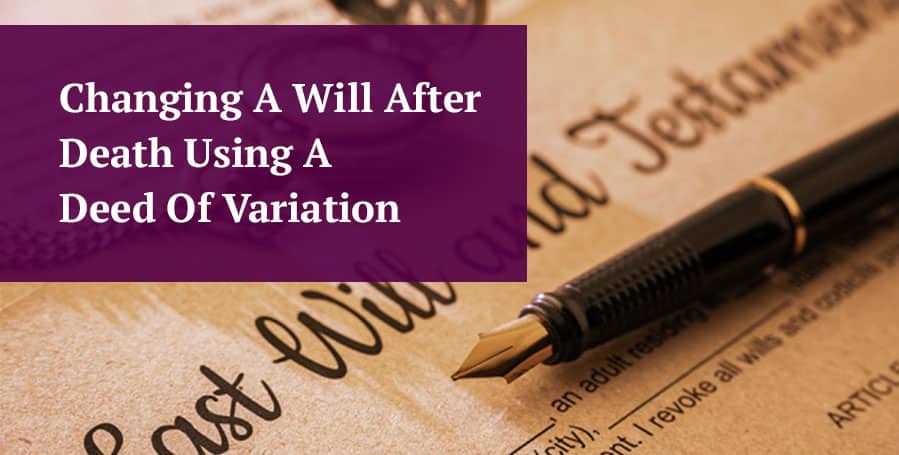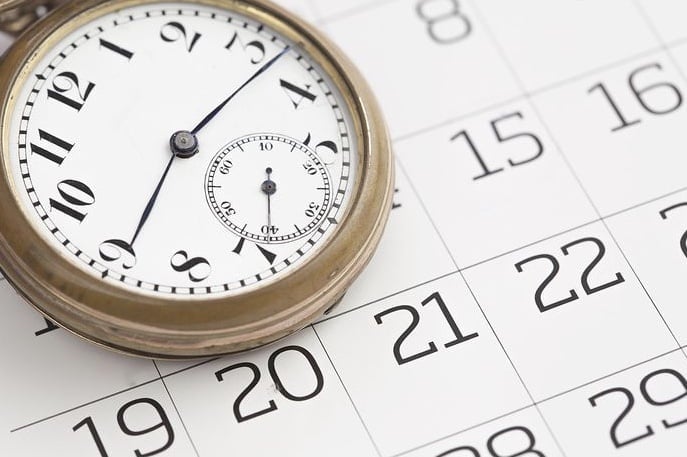Changing A Will After Death Using A Deed of Variation
Posted by David Cammack on August 14, 2018
Can you change a will after death? The answer is a simple ‘yes’. Changing a will after death is straightforward and can be done using a deed of variation of a will.

A deed of variation enables a beneficiary to vary a will, after the death of the person whose will it is, as to all, or part, of the beneficiary’s entitlement under the terms of the will.
Who Signs The Deed of Variation?
When changing a will after death, the deed of variation that is used must be signed by all beneficiaries that are affected by the change, in order for it to be valid.
There are many articles on the Internet that state that all beneficiaries receiving something under the terms of the will must agree and must sign the deed of variation, and/or that the executors must also sign the deed of variation. These are not correct, as the legal position is that only the beneficiaries that the change affects need to sign.
One complication that can arise is that if any of the beneficiaries that are affected by the intended change (i.e. who are giving up an inheritance or part of it) are under 18 years of age, then you will need to apply to the court for permission, in order to make it binding on them. In practice this is usually rare.
Can an Executor Change a Will After Death?
The executors under a will cannot change the will after the person that created the will has died, unless all of the beneficiaries that are affected by the change agree. As we mention above, the deed of variation must be signed by all beneficiaries affected by change.
Ideally, the executors of the will should consult with all the affected beneficiaries, to avoid any risk of a subsequent dispute, but legally the will can be validly changed, provided that the beneficiaries who will be affected agree.
Time Limit For Changing a Will After Death

Beneficiaries can put in place a deed of variation either before or after obtaining probate. You must do it within two years of the date that the deceased passed away.
If you attempt to change a will later on, it will be invalid: you gain no Inheritance Tax benefits. It will become a lifetime gift by the original beneficiary of the inheritance. If you then survive 7 years, there is no inheritance tax on it.
Changing a Will After Death – Why?
There are many reasons why the beneficiaries under a will may want to change the terms of the will after the death of the deceased. Common reasons include:
-
To add in a family member born since the date of the will.
Where a will was put in place a number of years before the deceased passed away, it is quite possible that some recently-born family members may not have been included in the will. In this situation, family members who are beneficiaries under the will may choose to vary the terms of the will to allocate some of the estate left to them to another family member.
-
Balancing up bequests made under the will.
The deceased may have chosen to make certain bequests under the will that the beneficiaries do not consider to be fair. Provided that all of the beneficiaries affected agree, then the bequests can be varied in the manner/proportions that they agree.
-
To resolve a dispute under the terms of the will.
Unfortunately it is not uncommon for family members to complain that the terms of a will are unfair, or about being left out of the will. Where the beneficiaries agree to change the will to resolve the dispute, you can use a deed of variation. This can often avoid a claim under the Provision for Family and Dependants Act 1975.
-
To achieve a more tax-efficient distribution of assets
In some situations the will may not allocate assets in a way that minimises liability to Inheritance Tax and maximises Capital Gains Tax allowances. In such circumstances, the beneficiaries under the will may agree a variation to achieve a more tax-efficient position. Sometimes this involves gifting part of the estate to charity, in order to avoid Inheritance Tax on it.
-
To pass assets down to the next generation
However, in most cases that we come across, it is simply to pass the assets from members of one generation, who do not need them, to a younger generation, who might have more need for them. In this way, the older generation avoid taking on more assets, which will most likely only push more of their estate over the Inheritance Tax threshold.
Legal Requirements For Changing A Will After Death
For the deed of variation to be valid, it is essential that you bear in mind the following requirements.
1. The deed of variation must be in writing in the form of a ‘deed’. As mentioned above, this means that everyone signing the deed of variation (i.e. generally only the beneficiaries affected by the change) must each sign the document in the presence of a witness. Each witness should be:
- someone that is independent,
- not a family member of any signatory, and
- not a family member of another beneficiary under the will you are varying.
2.The wording must be clear, so that the full identity of the new beneficiary is given. This should include their full name and their address.
3. You must make the deed making the change to the will within two years of the death of the deceased. (We mention this above.)
The Government has published a checklist form that you can use to check that the variation will be legally valid. The form is Form IOV2. Our template deed of variation complies with all of these requirements, so you can use it with peace of mind.
What to do with the deed of variation once signed
A further point to bear in mind is that if the change to the will results in more Inheritance Tax becoming payable (this is unusual), then the executors must notify HM Revenue and Customs within six months of the date of the deed of variation, and send HMRC a copy of the deed.
You should clearly send a copy of the deed to:
- the executors; and
- any lawyers dealing with the estate,
so they know to change the distribution of the assets as per the deed of variation.
Otherwise, you do not need to file a copy of the deed with anyone. You should ensure that the beneficiary who is giving up their legacy keeps the original. He or she should keep it with his or her will. You might later need it in order to prove it was not a lifetime gift. This is only critical if this beneficiary passes away within 7 years of the deed of variation. Technically, after 7 years you could throw it away.
Changing a Will after Death – what to do next
So, as you can see, the requirements for the deed to change the will after death are relatively straightforward. Now you know what to do, if you need a template for a deed of variation for a will, you can find ours here.
A UK Solicitor has drafted our deed of variation template to ensure accuracy. It is much more cost-effective than hiring a solicitor to create one for you.
More information on changing a will after death can be found on the government’s website.
Get Legal & Compliance tips straight to your inbox, free!
"*" indicates required fields